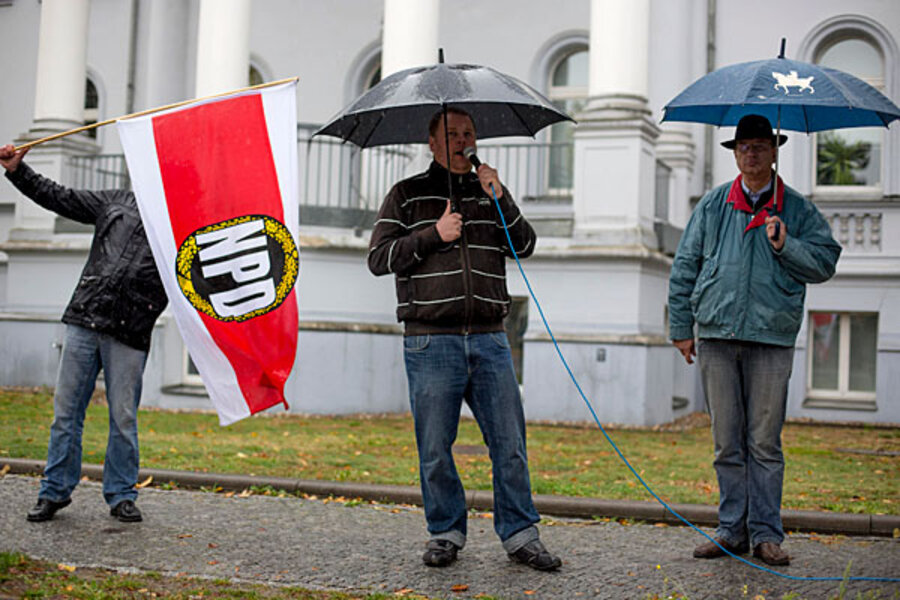Germans move to quash rising right-wing extremism
Loading...
| Dresden, Germany
Councilman Jörg Lämmerhirt wanted people to stop looking the other way.
In his Dresden districts, including one of myriad shoe-box-shaped "Plattenbauten" – housing communities that communists in the former East Germany built hastily from large concrete slabs, or "platten" – too few people reacted to the racist stickers with slogans like "National Socialism, Now!" and "Germany, Wake Up!" plastered on lampposts and bus stations. Young right-wingers, calling themselves "Free Forces," were left to take over local playgrounds, chasing kids away. And the far-right National Democratic Party of Germany (NPD) scored strongly in municipal and regional elections.
So Mr. Lämmerhirt pushed back – and joined a growing backlash against right-wing extremism in Germany, particularly eastern Germany, where xenophobia festered during the communist era and after reunification. Although right-wing attitudes are still prevalent in the east, people like Lämmerhirt are promoting awareness of the problem and working to counter it.
A latent problem
Twenty years after rioting neo-Nazis set fire to a hotel that was housing asylum seekers in the eastern port city of Rostock, thereby bringing the world’s attention to right-wing violence in the former communist Germany, right-wing attitudes remain part of the fabric of society, particularly in eastern Germany and among young people, according to a new study.
In regions often battered by depopulation and unemployment – and where foreigners are almost absent – 15.8 percent of residents espouse rightist, extremist views, up from 10.5 percent two years ago, and compared with 7.3 percent in western Germany, according to the study by the Berlin-based Friedrich Ebert Foundation, a democracy-education organization close to the Social Democratic Party. Forty percent of residents in eastern regions express antiforeigner views today compared with 20 percent in the west.
"The study shows it once again. We have a problem with right-wing extremism, especially in the East," says Christian Demuth, who created the antiracism "Citizen.Courage" group six years ago to rally residents against a yearly neo-Nazi march marking the Allied bombing of the city at the end of World War II.
Released just days after German prosecutors formally charged the last surviving member of a neo-Nazi cell in Zwickau that was allegedly involved in the murder of at least 10 migrants in recent years, the study shows that extremism in Germany is not confined to isolated acts of violence, experts say. Rather, and especially in Germany’s east, it is an entrenched attitude of turning a blind eye born out of decades of dictatorship. The study, they hope, will reinvigorate efforts to break away people's apathy.
"Back a few years ago, people didn’t do anything because they didn’t care," says Mr. Demuth. "But there is a countermovement, a public debate about what to do to fight neo-Nazism."
The mental legacy of East Germany
In August when he came to Rostock, where he had been a pastor on the 20th anniversary of the riots, German President Joachim Gauck said right-wing extremism’s stronger prevalence in the east resulted from people thinking "in black and white" after being deprived of democracy for decades.
Right-wing extremism is the "mental legacy" of communism, concurs Klaus Schroeder, an expert on right-wing terrorism at Berlin’s Free University. The vicious attack against Vietnamese, Roma, and Sinti asylum seekers in Rostock 20 years ago – and the fact that it was only timidly condemned – is a case in point, he says.
"What happened there, with people clasping hand, cheering, and jubilating could have never happened in the west," says Mr. Schroeder. "There was a feeling of unlimited freedom, of ‘we can go out and beat foreigners up."
In East Germany, people’s collective responsibility for Third Reich crimes was not discussed openly, nor was how to deal with the roughly 200,000 "contract workers" the communists imported from countries like Cuba, Vietnam, and Congo.
"When a skinhead beat up a worker from Mozambique it wasn’t in the newspapers," says Schroeder. "The state handled everything. Things were put under the carpet." And after German reunification, people "were left in a vacuum, without a sense of orientation," which was fertile ground for xenophobia and extremist attitudes to grow.
In many eastern towns and villages today, officials from the right-wing NPD party still sit on town boards and organize sports and youth activities, say experts. Often, residents do not see the NPD as being a "problem party."
Backlash
In the east, "People take freedom and democracy in stride, but they’re not willing to get involved and defend it," says Schroeder.
But Demuth's and Lämmerhirt's initiatives suggest that things are changing. From Berlin to Dresden and Rostock, a grass-roots movement to counter right-wing extremism is gaining ground.
Fed up with people’s silence, Lämmerhirt two years ago helped create the "Laubegast is colorful" civic program. Named after one of the Dresden neighborhoods he represents, it aims at bringing together people and rallying them against right-wing extremism.
"We wanted to get the problem of right-wing extremism to become a public discussion," he says. "To show that the NPD answers are too easy."
And last year, counter-demonstrators outnumbered neo-Nazis participating in the traditional "march of mourning" in Dresden, says Demuth. "The Feb. 13 march is still there, but now it’s accepted you’re always going to have a countermovement," he says.
Federal authorities have taken steps against right-wing violence, establishing a central register of neo-Nazis and opening a Joint Defense Center Against the Far Right, for instance.
But for anti-neo-Nazi activists like Irmela Mensah-Schramm, who spends much of her free time removing neo-Nazi stickers and slogans in Berlin, even better would be that people get rid of racist stickers themselves. Ms. Mensah-Schramm has collected 5,450 photos and 1,100 stickers of right-wing propaganda over the years, which she circulates to city halls, theaters, youth centers, and schools as part of an exhibit called "Hatred destroys."
"Citizens have to learn how to have more guts," she says.







